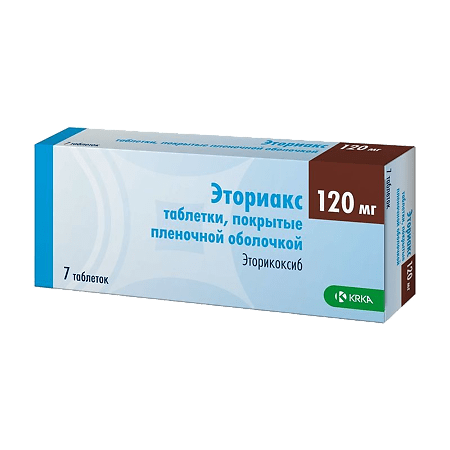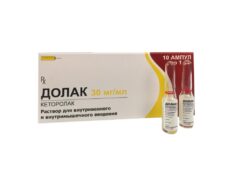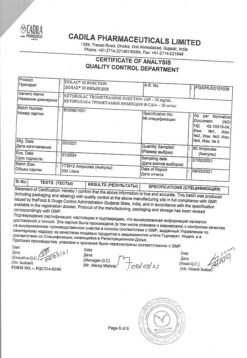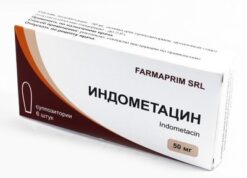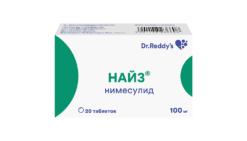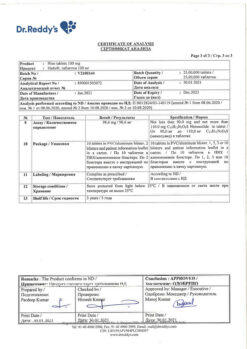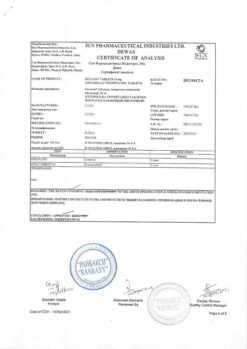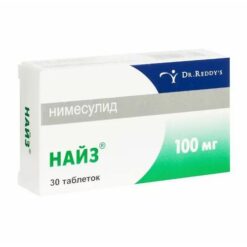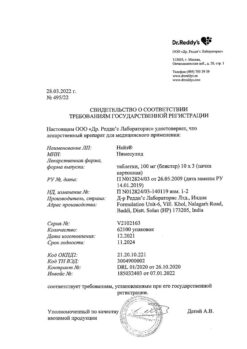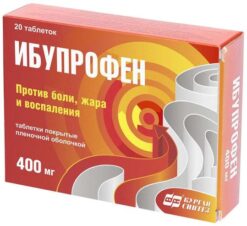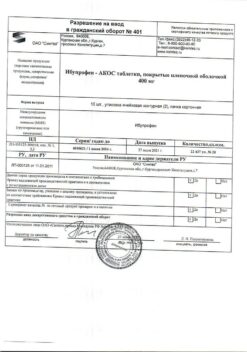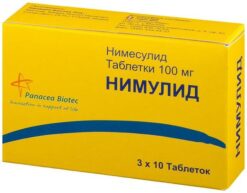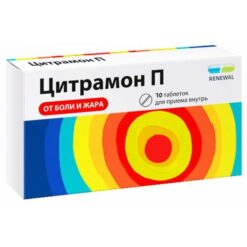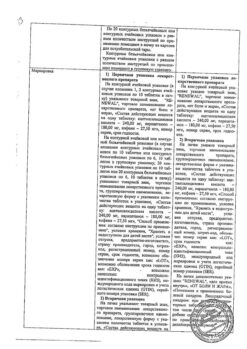No products in the cart.
Etoriax, 120 mg 7 pcs.
€1.00
Out of stock
(E-mail when Stock is available)
Description
Symptomatic relief of osteoarthritis, rheumatoid arthritis, ankylosing spondylitis, and pain and signs of inflammation associated with acute gouty arthritis in adults and adolescents 16 years and older.
The short-term treatment of moderate pain associated with dental surgery in adults and adolescents 16 years of age and older.
Active ingredient
Active ingredient
Composition
Composition
1 film-coated tablet, 120 mg contains:
Core:
Active substance:
Etoricoxib 120.00 mg
Associates: microcrystalline cellulose, type KG-802, microcrystalline cellulose, type PH-200 LM, calcium hydrophosphate, croscarmellose sodium, sodium stearyl fumarate, colloidal silicon
Film coating: Opadray 85F28751 II white* (polyvinyl alcohol, titanium dioxide (E171), macrogol-3000, talc), iron oxide red dye (E172).
* Opadray 85F28751 II white is a ready-to-use dry mixture of polyvinyl alcohol, titanium dioxide (E171), macrogol-3000 and talc.
How to take, the dosage
How to take, the dosage
Interaction
Interaction
PDV
Peroral anticoagulants. In patients stabilized on long-term warfarin therapy, etoricoxib at a dose of 120 mg/day has been associated with an increase in INR and PV of approximately 13%. Therefore, in patients taking oral anticoagulants, PV should be monitored, especially in the first few days after starting etoricoxib or changing its dose (see “Precautions”).
Diuretics, ACE inhibitors, and ARA II. NSAIDs may reduce the effect of diuretics and other antihypertensive drugs. In some patients with impaired renal function (e.g., dehydrated or elderly patients with impaired renal function), co-administration of ACE inhibitor or ARA II and COX inhibitors may lead to further impairment of renal function, including development of acute renal failure, which is usually reversible. This interaction should be considered in patients taking etoricoxib concomitantly with ACE inhibitors or ARA II. Therefore, concomitant use of these drugs should be administered with caution, especially in the elderly. Adequate hydration should be performed in such patients, and attention should be paid to monitoring renal function after initiation of concomitant therapy and periodically thereafter.
Acetylsalicylic acid. In a study involving healthy volunteers, etoricoxib at a dose of 120 mg once daily in equilibrium did not affect the antiplatelet activity of acetylsalicylic acid (81 mg once daily). Etoricoxib can be used concomitantly with acetylsalicylic acid in doses used for the prevention of cardiovascular disease (low doses). However, concomitant use of low doses of acetylsalicylic acid with etoricoxib may lead to an increased incidence of GI ulcers or other complications compared to the use of etoricoxib alone. Concomitant use of etoricoxib with acetylsalicylic acid in doses greater than prophylactic or with other NSAIDs is not recommended (see “Precautions”).
Cyclosporine and tacrolimus. The interaction of these drugs and etoricoxib has not been studied, but co-administration of cyclosporine or tacrolimus with any NSAID may increase their nephrotoxic effects. Renal function should be monitored when co-administering etoricoxib and any of these drugs.
PFCs
The effect of etoricoxib on the pharmacokinetics of other drugs
Lithium-containing drugs. NSAIDs decrease renal excretion of lithium and therefore increase plasma lithium levels. If this combination is necessary, blood lithium levels should be monitored closely, and the dose of lithium should be adjusted when taking them together and after discontinuation of NSAIDs.
Methotrexate. Two studies investigated the effects of etoricoxib in doses of 60, 90, or 120 mg once daily for seven days in patients receiving methotrexate to treat RA in doses ranging from 7.5 to 20 mg once weekly. Etoricoxib at doses of 60 and 90 mg had no effect on plasma methotrexate concentrations or renal clearance. In one study, etoricoxib at a dose of 120 mg had no effect, but in another study it increased the plasma concentration of methotrexate by 28% and decreased its renal clearance by 13%. Adequate monitoring of methotrexate-related toxicity is recommended with concomitant administration of etoricoxib and methotrexate.
The oral contraceptives. Concomitant use of etoricoxib at a dose of 60 mg and oral contraceptives (35 mcg ethinylestradiol and 0.5-1 mg norethindrone) for 21 days, increased the AUC0-24 of ethinylestradiol by 37%. Etoricoxib at a dose of 120 mg, taken with the same oral contraceptive at the same time or 12 h apart, increased the AUC0-24 of ethinylestradiol by 50-60%. This increase in ethinylestradiol concentration should be considered when selecting an oral contraceptive for coadministration with etoricoxib. Increased ethinylestradiol exposure may increase the incidence of adverse reactions associated with oral contraceptives (e.g., venous thromboembolic events in women at risk).
ZGT. Concomitant use for 28 days of etoricoxib at a dose of 120 mg and ZHT consisting of conjugated estrogens (0.625 mg premarin) increased the mean equilibrium AUC0-24 of unconjugated estrone (41%), equiline (76%), and 17-β-estradiol (22%). The effects of the recommended doses of etoricoxib (30, 60, and 90 mg) in long-term use have not been studied. The effect of etoricoxib at a dose of 120 mg on the AUC0-24 of these estrogenic components of premarin was more than half that observed when taking premarin alone and increasing the dose from 0.625 to 1.25 mg. The clinical significance of these data is unknown; higher doses of premarin in combination with etoricoxib have not been studied. This increase in estrogen concentrations should be considered when choosing postmenopausal hormone therapy when combined with etoricoxib, as increased estrogen exposure may increase the risk of adverse reactions associated with MHT.
Prednisone/prednisolone. In interaction studies, etoricoxib had no clinically significant effect on the pharmacokinetics of prednisone/prednisolone.
Digoxin. Administration of etoricoxib at a dose of 120 mg once daily for 10 days in healthy volunteers did not alter equilibrium plasma AUC0-24 or renal elimination of digoxin. An increase in Cmax of digoxin (approximately 33%) was observed. This increase is generally not clinically significant in most patients. However, concomitant administration of etoricoxib and digoxin should be monitored in patients at high risk of digoxin toxicity.
The effect of etoricoxib on drugs metabolized by sulfotransferases
Etoricoxib is an inhibitor of human sulfotransferase activity, particularly SULT1E1, and has been shown to increase serum ethinylestradiol concentrations. Although knowledge of the effects of sulfotransferases is currently limited and clinical implications for many drugs are still being studied, caution should be exercised when concomitantly prescribing etoricoxib with other drugs that are primarily metabolized by human sulfotransferases (e.g., oral salbutamol and minoxidil).
The effect of etoricoxib on drugs metabolized by CYP450 isoenzymes
Based on in vitro studies, etoricoxib is not expected to inhibit CYP1A2, CYP2C9, CYP2C19, CYP2D6, CYP2E1 or CYP3A4. In a study involving healthy volunteers, daily administration of etoricoxib at a dose of 120 mg did not alter hepatic CYP3A4 activity by the erythromycin breath test.
The effect of other drugs on the pharmacokinetics of etoricoxib
The main route of metabolism of etoricoxib depends on CYP450 enzymes. CYP3A4 appears to be involved in the metabolism of etoricoxib in vivo. In vitro studies show that CYP2D6, CYP2C9, CYP1A2 and CYP2C19 can also catalyze the major metabolic pathway, but their quantitative role in vivo has not been studied.
Ketoconazole. Ketoconazole, a strong CYP3A4 inhibitor, taken at a dose of 400 mg once daily for 11 days in healthy volunteers had no clinically significant effect on the pharmacokinetics of a single dose of 60 mg etoricoxib (43% increase in AUC).
Voriconazole and miconazole. Co-administration of voriconazole or topical myconazole gel, strong CYP3A4 inhibitors, and etoricoxib caused a slight increase in the pharmacological activity of etoricoxib, but this effect is not considered clinically significant.
Rifampicin. Co-administration of etoricoxib and rifampicin, a strong inducer of CYP450 isoenzymes, resulted in a 65% decrease in plasma concentration of etoricoxib. This interaction may lead to a relapse of disease symptoms when etoricoxib is coadministered with rifampicin. Although this information may justify increasing the dose of etoricoxib, there are no data on the effect of etoricoxib at an increased dose when it is combined with rifampicin, so increasing the dose is not recommended.
Antacids. Antacids do not affect the pharmacokinetics of etoricoxib to a clinically significant degree.
Special Instructions
Special Instructions
Gastrointestinal effects
In patients receiving etoricoxib, upper gastrointestinal complications (perforations, ulcers or bleeding) have been observed, some of which have been fatal.
We recommend caution when using etoricoxib in patients at increased risk of gastrointestinal complications when using NSAIDs, the elderly, patients taking any other NSAIDs or acetylsalicylic acid concomitantly, and patients with a previous history of GI disease, such as GI ulcers and bleeding.
Concomitant use of etoricoxib and acetylsalicylic acid (even at low doses) increases the risk of adverse GI reactions (ulceration or other gastrointestinal complications). A significant difference in GI safety between COX-2 selective inhibitors + acetylsalicylic acid and NSAIDs + acetylsalicylic acid has not been demonstrated in long-term clinical trials.
Impact on cardiovascular events
Clinical studies suggest that the use of selective COX-2 inhibitors may be associated with the risk of thrombotic complications (especially myocardial infarction and stroke) compared to placebo control and some NSAIDs. Since the cardiovascular risks of etoricoxib may increase with increasing dose and duration of administration, the shortest possible course and the lowest possible daily dose to produce the desired effect should be used. The patient’s need for symptom relief and response to therapy should be periodically reviewed, especially in patients with OA (see Contraindications, Side Effects).
Patients with significant risk factors for cardiovascular complications (e.g., hypertension, hyperlipidemia, diabetes mellitus, smoking) should be treated with etoricoxib only after a thorough evaluation.
The selective COX-2 inhibitors are not a substitute for acetylsalicylic acid for the prevention of cardiovascular thromboembolic events because of their lack of antiplatelet effect. Therefore, antiplatelet therapy should not be discontinued (see “Interactions”).
The effects on the kidneys
Renal PGs may play a compensatory role in maintaining renal perfusion. Therefore, under conditions of impaired renal perfusion, administration of etoricoxib may cause a decrease in PG production and, secondarily, in renal blood flow and thereby impair renal function. Patients with pre-existing significant impairment of renal function, uncompensated heart failure or cirrhosis are at greatest risk of such a reaction. Renal function should be monitored in these patients.
Fluid retention, edema and hypertension
As with other GHG synthesis inhibitors, fluid retention, edema and hypertension have been observed in patients taking etoricoxib. Use of all NSAIDs, including etoricoxib, may be associated with the onset or recurrence of congestive heart failure. Caution should be exercised in patients with heart failure, history of left ventricular dysfunction or hypertension, as well as in patients with pre-existing edema of other etiology. If there are clinical signs of deterioration in these patients, appropriate measures should be taken, including discontinuation of etoricoxib.
The administration of etoricoxib may be associated with more frequent and severe hypertension than the administration of some other NSAIDs and COX-2 selective inhibitors, especially in high doses. Therefore, hypertension should be monitored prior to treatment with etoricoxib (see Contraindications) and special attention should be paid to BP control during treatment with etoricoxib. BP should be monitored for 2 weeks after initiation of treatment and periodically after discontinuation of etoricoxib. If the BP rises significantly, alternative treatment should be considered.
Synopsis
Synopsis
Tablets 30 mg:
Round, slightly biconvex tablets, film-coated white or almost white, with bevel.
Breakage appearance: white or almost white rough mass with white or almost white film coating.
Tablets 60 mg:
Round, biconvex, film-coated tablets, light brownish-yellow, beveled, with “60” engraved on one side.
Breakage appearance: white or almost white rough mass with light brownish-yellow film coating.
Tablets 90 mg:
Round, biconvex, film-coated tablets in pink, beveled, with “90” engraved on one side.
Breakage appearance: white or almost white rough mass with a pink film coating.
Tablets 120 mg:
Round, slightly biconvex, film-coated, brownish-red tablets, beveled, with a bevel on one side.
Breakage appearance: white or almost white rugged mass with brownish-red film coating .
Contraindications
Contraindications
Side effects
Side effects
Safety Profile Review
The safety of etoricoxib was evaluated in 9,295 people in clinical trials, including 6,757 patients with OA, RA, chronic low back pain or ankylosing spondylitis (about 600 patients with OA or RA were treated for one year or longer).
In clinical trials, the profile of adverse events was similar in patients with OA or RA who received etoricoxib for one year or longer.
In a clinical trial of acute gouty arthritis, patients took etoricoxib 120 mg once daily for eight days. The side effect profile in this study was broadly similar to that reported in the pooled studies of OA, RA, and chronic low back pain.
In the CCC safety evaluation program, which included pooled data from three active comparative controlled trials, 17412 patients with OA or RA took etoricoxib (60 or 90 mg) for about 18 months. For safety data and details of this program, see. “Pharmacology,” Clinical Studies.
In clinical trials involving 614 patients with acute postoperative toothache who received etoricoxib (90 or 120 mg), the adverse event profile was generally similar to that reported in the pooled studies of OA, RA and chronic low back pain.
. Table 2 summarizes adverse reactions reported with a frequency greater than placebo in clinical trials in patients with OA, RA, chronic low back pain, or ankylosing spondylitis receiving etoricoxib at doses of 30, 60, or 90 mg for 12 weeks, in MEDAL studies over 3.5 years, in short-term acute pain studies over 7 days, or in post-registration follow-ups.
Table 2
1 Frequency Category: Defined for each adverse event term by the frequency reported in the clinical trials database: very common (â¥1/10); common (â¥1/100, < 1/10); infrequent (â¥1/1000, < 1/100); rare (â¥1/10000, < 1/1000); very rare(< 1/10000).
2 This adverse reaction was identified during post-registration follow-up. Its frequency was estimated based on the highest frequency observed in clinical trials pooled by indication and approved dose.
3 Hypersensitivity includes the terms allergy, drug allergy, drug hypersensitivity, drug hypersensitivity, unspecified hypersensitivity, hypersensitivity reaction, and non-specific allergy.
4 Based on an analysis of data from long-term controlled placebo and active-controlled clinical trials, selective COX-2 inhibitors increased the risk of serious thrombotic arterial events, including myocardial infarction and stroke. According to current data, the absolute increase in the risk of such events is not higher than 1% per year (infrequent).
The following serious adverse reactions have been reported in connection with the use of NSAIDs that cannot be excluded for etoricoxib: nephrotoxicity, including interstitial nephritis and nephrotic syndrome.
Overdose
Overdose
In clinical trials, the use of single doses of etoricoxib up to 500 mg and multiple doses up to 150 mg/day over 21 days has not resulted in significant toxicity. There have been reports of acute etoricoxib overdose, although in most cases no adverse effects have been reported. The most commonly observed adverse events were consistent with the safety profile of etoricoxib (e.g., gastrointestinal, cardiorenal events).
Treatment: In case of overdose, it is reasonable to apply the usual supportive measures, such as removal of unabsorbed etoricoxib from the GI tract, clinical monitoring and, if necessary, supportive therapy.
Etoricoxib is not eliminated by hemodialysis; it is not known whether etoricoxib is eliminated by peritoneal dialysis.
Pregnancy use
Pregnancy use
Etoricoxib is contraindicated in pregnancy (see Contraindications). If a woman becomes pregnant during treatment, etoricoxib should be discontinued.
There are no clinical data on pregnant women exposed to etoricoxib. Animal studies have shown marked reproductive toxicity. The potential risk to women in pregnancy is unknown. Etoricoxib, like other drugs that inhibit PG synthesis, can cause uterine inertia and premature closure of the arterial ductus in the last trimester of pregnancy.
It is not known whether etoricoxib is excreted with milk in women. Etoricoxib is excreted in the milk of lactating rats. Women using etoricoxib should not breastfeed (see Contraindications).
The effect on fertility. The use of etoricoxib, like any other COX-2 inhibitor, is not recommended for women planning to become pregnant.
Similarities
Similarities
Additional information
| Weight | 0.120 kg |
|---|---|
| Shelf life | 3 years. Do not use the product after the expiration date. |
| Conditions of storage | At the temperature not more than 25 ° C, in the original package. Store out of reach of children. |
| Manufacturer | KRKA dd Novo mesto, Slovenia |
| Medication form | pills |
| Brand | KRKA dd Novo mesto |
Related products
Buy Etoriax, 120 mg 7 pcs. with delivery to USA, UK, Europe and over 120 other countries.

